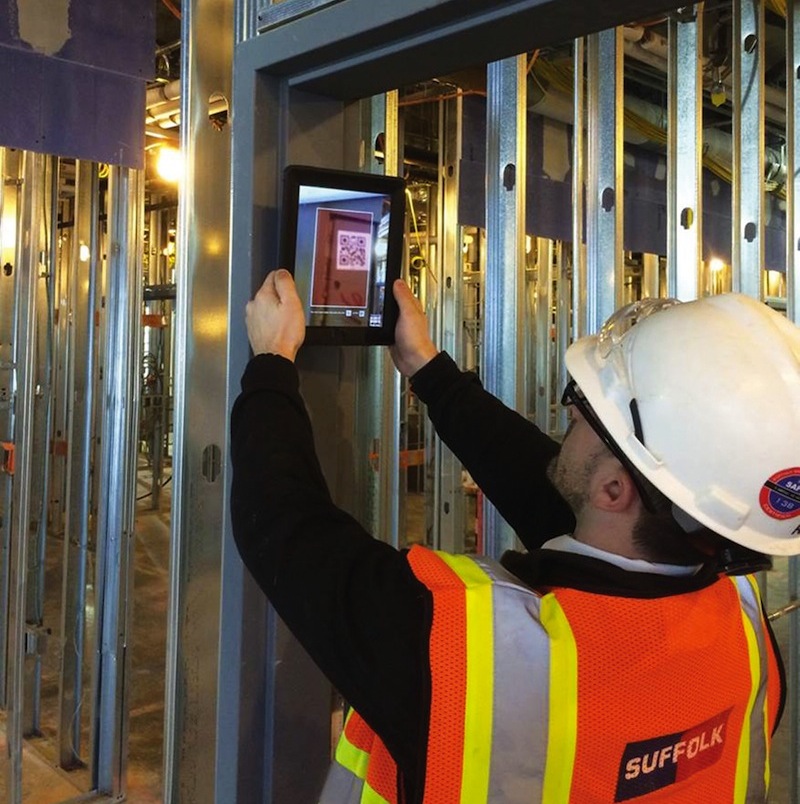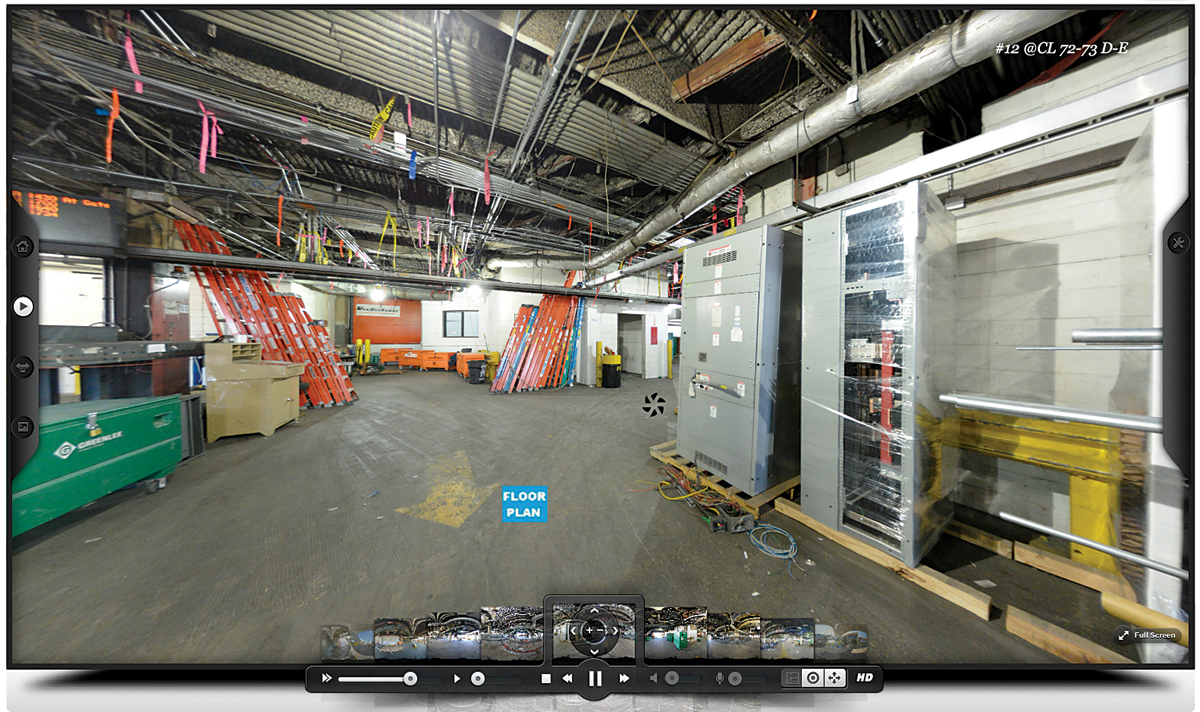Drones, GoPro, RFID, Oculus Rift, augmented reality, 360 cameras, 3D laser scanners, GIS systems. There’s no shortage of tech gadgets that are ripe for adoption on commercial construction projects. Making these tech tools even more enticing for construction firms are the low barrier to entry—for example, professional-grade drones go for as low as $650—and improved integration with existing workflows and systems.
“It’s been overwhelming at times just trying to get a handle on all the new innovations,” says James Barrett, VP and Chief Innovation Officer with Turner Construction. “It’s easy to get caught up in the coolness of these tools, but I feel like some of them are just a solution looking for a problem.” Turner takes an incremental approach to technology adoption, selecting the tools that offer the most favorable cost-to-benefit ratio.
In late 2013, Suffolk Construction formed a 12-person R&D team to help keep up with emerging technologies. The group, led by Senior Project Manager Jason Seaburg, has a formal process for testing new gadgets, including twice-monthly conference calls and timelines for testing.
“We work in an industry that, quite honestly, is a decade behind the times when it comes to technology,” says Seaburg. “We need to foster a culture and mindset where it’s OK to beta test all these new technologies hitting the market, and where it’s OK to fail. If a particular tool doesn’t work, that’s fine, we’ll move on to the next thing.”
To find out which technologies are working for contractors, and which emerging applications show promise, BD+C reached out to several giant contractor firms. Here’s what they had to offer:
1. 360 cameras simplify visual documentation.
Manhattan Construction has seen huge benefits from the use 360 cameras. Manhattan’s Mark Penny, an SVP in the firm’s Dallas office, says the technology has greatly reduced the need for client/team site visits on the multi-year DFW International Airport modernization and improvement project. It also has assisted the team with making sense of the existing conditions (very few as-built drawings exist) and documenting the construction progress.
Every two weeks, during routine field walks of the job site, the project’s superintendent uses a Nikon D7100, fitted with a fisheye lens for panoramic shots, to take four images from dozens of predetermined locations across the site. The images from each location are then stitched together using PTGui software (www.ptgui.com) and linked to a custom digital floor plan of the project via Real Tour Vision (www.realtourvision.com), allowing anyone on the team to take a virtual, high-definition tour of the facility.
“Say there’s a conflict with ductwork,” says Penny. “We can pull up the latest photo of that area, pan and zoom to that exact spot, and collaborate with the designers and client—virtually—to resolve it.”
2. Teams are taking control of video.
Tech gadgets like drones, GoPros, and tablets make video capture a breeze in the field. The issue for contractors is what to do with the information—how best to archive video for future use, or tie it in with the construction information workflow.
Both Suffolk and Turner are working with software developers to create custom tools to help take control of their video data. Suffolk is planning a YouTube-like website that will allow its staff to upload and quickly retrieve project videos. The most novel feature: an advanced search function that will take viewers to a specific point of a video based on keyword input. “It could be a three-hour project video, but you need to see the foundation installation at the 12-minute mark,” says Seaburg. “This tool will take you to that exact spot.”
Turner is working with software engineers at the University of Illinois at Urbana–Champaign to develop an automated safety check program that will analyze video feeds to identify workers who are not wearing safety gear, such as hardhats, vests, and glasses. “Our push has been to leverage easily accessible technologies, like video and photos, combined with advanced analysis, to solve problems,” says Barrett.
3. Rise of the smart factory network.
No tech innovation is making a bigger impact on construction projects than prefabrication, says Barrett. Building Teams are experiencing sizable gains in schedule and workforce efficiencies, and are looking for new ways to move the “big thinking” off the job site and into a factory-like setting. Precast exterior walls, unitized curtain wall, multi-trade racks, bathrooms pods, prefab head walls, and equipment skids are now commonplace on major projects. Emerging applications include precast foundations and interior partitions.
“The smartest job site is not one site, but a network of job sites where trade contractors are prefabricating components in a clean, controlled environment, and then delivering them only as needed,” says Barrett.
Trade contractors are becoming increasingly sophisticated, says Barrett. He points to Quakertown, Pa.-based Klover Contracting, which recently launched a BIM-to-cold-roll-forming-machine workflow for the manufacture of light-gauge metal frame components for a variety of applications—interior partitions, roof and floor trusses, load-bearing wall panels, to name a few. Based on the rough BIM model for a given project, Klover’s team can create a detailed framing design that incorporates door/window openings, structural requirements, duct openings, and panel breaks. This file is then sent to the firm’s cold-roll forming machines, which “print” each component to precise specifications.
4. BIM in the field is starting to pay off.
 To speed the site inspection process at the 620,000-sf, 11-story Brigham Building for the Future project at Brigham and Women’s Hospital in Boston, Suffolk Construction implemented a QR-code-based BIM-in-the-field workflow. Team members can quickly call up documents for a given space and provide real-time feedback by scanning a QR code label affixed to the nearest doorframe. Courtesy Suffolk Construction
To speed the site inspection process at the 620,000-sf, 11-story Brigham Building for the Future project at Brigham and Women’s Hospital in Boston, Suffolk Construction implemented a QR-code-based BIM-in-the-field workflow. Team members can quickly call up documents for a given space and provide real-time feedback by scanning a QR code label affixed to the nearest doorframe. Courtesy Suffolk Construction
Suffolk is rolling out Autodesk’s BIM 360 Glue (cloud-based BIM/VDC coordination) and 360 Field (mobile project management) across the organization. One of the most useful applications, says Seaburg, is quality control inspection using the BIM 360 Field app on iPads, combined with QR codes on the job site.
On the firm’s $280 million, 620,000-sf Brigham Building for the Future project, currently under construction in Boston, the team placed QR codes on the door frames of every space in the complex. During work-list inspections (and eventually punch-list inspections), team members can open the 360 Field app and scan the QR code of a given room for a detailed, real-time list of work to be completed and questions to be addressed.
“From there, we can change the status, add comments, put it in dispute, mark it as complete, and even add a picture,” says Tom Reid, Suffolk’s Assistant Project Manager. “It allows us to work through lists almost in real time.”
5. RFID is on the cusp of going mainstream.
Turner has been studying RFID tracking for several years, and has implemented RFID solutions intermittently—with reasonable success, says Barrett.
“We’re chasing the low-hanging fruit, like tracking workers as they enter and leave the site, and to see if they’re up to date on their certifications,” he says. With newer solutions, like Trimble’s CrewSight system, Barrett believes RFID is ready for prime time.
“Costs have come down, and it’s becoming easier to deploy,” he says. “We’re looking to make it standard on projects.”
Related Stories
| Aug 11, 2010
Gensler among eight teams named finalists in 'classroom of the future' design competition
Eight teams were recognized today as finalists of the 2009 Open Architecture Challenge: Classroom. Finalists submitted designs ranging from an outdoor classroom for children in inner-city Chicago, learning spaces for the children of salt pan workers in India, safe spaces for youth in Bogota, Colombia and a bamboo classroom in the Himalayan mountains.
| Aug 11, 2010
AECOM, WATG top BD+C's ranking of the nation's 75 largest hotel design firms
A ranking of the Top 75 Hotel Design Firms based on Building Design+Construction's 2009 Giants 300 survey. For more Giants 300 rankings, visit http://www.BDCnetwork.com/Giants
| Aug 11, 2010
Parsons Brinckerhoff, Dewberry among nation's largest multifamily design firms, according to BD+C's Giants 300 report
A ranking of the Top 75 Multifamily Design Firms based on Building Design+Construction's 2009 Giants 300 survey. For more Giants 300 rankings, visit /giants
| Aug 11, 2010
USGBC’s Greenbuild 2009 brings global ideas to local main streets
Save the planet with indigenous knowledge. Make permanent water part of your life. Dive deep water for clues to environmental success. Connect site selection to successful creative concepting. Explore the unknown with Discovery Channel’s best known guide. These are but a few of the big ideas participants can connect to at USGBC’s Greenbuild International Conference and Expo, taking place on November 11-13, 2009 in Phoenix, Ariz.
| Aug 11, 2010
Goettsch Partners wins design competition for Soochow Securities HQ in China
Goettsch Partners (GP) has been selected as the winning firm in the competition to design the Soochow Securities Headquarters, the new office and stock exchange building for Soochow Securities Co. Ltd. The 21-story, 441,300-square-foot project includes 344,400 square feet of office space, an 86,100-square-foot stock exchange, meeting rooms, classrooms, a cafeteria, and underground parking for 400 cars and 800 bicycles.
| Aug 11, 2010
RMJM unveils design details for $1B green development in Turkey
International architecture company RMJM today announced details of the $1 billion Varyap Meridian development it is designing in Istanbul’s new residential and business district, which will be one of the "greenest" projects in Turkey. The luxury 372,000-square-meter development on a site totalling 107,000 square meters will be located in the Atasehir district of Istanbul, which the Turkish government intends to transform into the country’s new financial district and business center.
| Aug 11, 2010
Urban Land Institute honors five 'outstanding' developments in Europe, Middle East, and Africa
Five outstanding developments have been selected as winners of the Urban Land Institute (ULI) 2009 Awards for Excellence: Europe, Middle East, and Africa (EMEA) competition. This year, the competition also included the announcement of two special award winners. The Awards for Excellence competition is widely regarded as the land use industry’s most prestigious recognition program.
| Aug 11, 2010
Design firms slash IT spending in 2009
Over half of architecture, engineering, and environmental consulting firms (55%) are budgeting less for information technology in 2009 than they did in 2008, according to a new report from ZweigWhite. The 2009 Information Technology Survey reports that firms' 2009 IT budgets are a median of 3.3% of net service revenue, down from 3.6% in 2008. Firms planning to decrease spending are expected to do so by a median of 20%.
| Aug 11, 2010
American Concrete Institute forms technical committee on BIM for concrete structures
The American Concrete Institute (ACI) announces the formation of a new technical committee on Building Information Modeling (BIM) of Concrete Structures.







